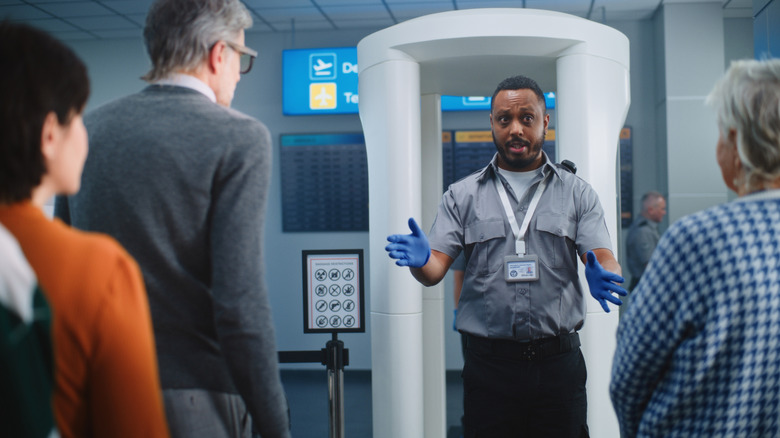Full-Body Scanners At The Airport Show More Than You May Realize
After September 11, 2001, airport security changed forever. In addition to having to take your shoes off (though that's being phased out), the newly created TSA was required by Congress to X-ray every piece of luggage in airports and screen every passenger on commercial flights from U.S. airports. As an enhanced security feature, TSA began using body scanners to check what passengers were carrying on them before boarding flights, after the so-called "underwear bomber" attempted a terror attack on December 25, 2009. Older backscatter machines, which were rapidly rolled out at the time, used invasive, low-level X-rays to conduct full-blown "digital strip searches" on the traveling public. But full-body scanners today reveal a different image to security officers.
Since 2016, the TSA has pivoted to using modern body scanners, which use Advanced Imaging Technology (AIT). As Shawna Malvini Redden, author of "101 Pat-Downs," explained to Reader's Digest, "The waves go through clothing and reflect off the passenger's skin (and whatever else is concealed) and bounce back an image, which is interpreted by the machine."
Unlike the machines from a decade ago, newer millimeter-wave AIT machines won't show your naked body on the screen to anyone, nor will they show anything physically inside of your body. Both you and the TSA agent should see the same picture: an innocuous doll-like illustration with highlighted areas that triggered the machine. Still, they could show surprising information, such as that you left a quarter in your pocket, have a skin tumor, or are sweating a little more than usual. And if you are concerned about passing through the body scanner, you normally have the option to receive a pat-down, either in public or in a private room.
How do AIT machines work?
The AIT machines at airports pick up more than just metallic objects. Since these machines emit millimeter waves, they can detect anything you are carrying on your person, including non-metal objects, powders, liquids, and gels. As a standard procedure, the scanning process is normally less than a minute and is deemed by the federal government to be safe – emitting 10,000 times less energy than a cellular phone – including for travelers who are using a medical device either inside or outside of their body. Enter the machine and follow the diagrams and footprints. Once the screening is complete, the officer will receive an "OK" or an alert of where the machine detected an abnormal object on your body. If the machine finds something, the officer may conduct a physical pat-down to double-check.
The newest generation of AIT scanners utilizes AI technology, and travelers passing through Denver International Airport, America's largest airport, can pass through this bottleneck by simply walking. New AI-integrated scanners can more accurately detect evolving security threats due to the algorithm being trained to spot abnormal objects. Constant training of the algorithm will aim to limit the machine sensing hair clips, piercings, wire supports, or sweat as false positives for officers to conduct pat-downs, making the process faster. In an interview with Transport Security International, Harald Jentsch, head of Aviation Security Screening for Rohde & Schwarz, even raised the idea of passengers potentially conducting their own self-screening in the future. Even if this is the case, TSA officers will still likely be present to watch for these behaviors that can raise red flags at airport security.
Body scanners are scanning more than what you carry
As technology is being further integrated into airport security checkpoints, body scanners aren't just recognizing what you are carrying on your body; they are scanning your face to verify your identity using existing biometric databases. TSA has begun integrating facial recognition at airports across the country with Credential Authentication Technology (CAT-2) machines. These machines integrate facial recognition technology and passenger manifest lists. Passengers insert their ID card into a machine and have their photo taken, as the machine matches the traveler's name and face across flight itineraries from the airport that day. Officers are still present to verify each traveler, as well as to ensure that you're going through the PreCheck lane if applicable. If you're uncomfortable with the idea of having your face scanned and saved for a few seconds (TSA states the photos are deleted after your identity is verified), you can opt for the old-school manual identification without being penalized.
At a handful of major airports, including Atlanta, Dallas-Fort Worth, Los Angeles, and Salt Lake City, TSA has taken facial recognition a step further for PreCheck members with a valid passport and their passport information saved with a participating airline. You'll be able to pass through security without even showing your ID (though keep it handy just in case), as long as your boarding pass shows the TSA PreCheck Touchless ID symbol. Similar to the CAT-2 machines, TSA states that travelers' photos and information are not used for conducting surveillance, nor shared with law enforcement, and are deleted within 24 hours.


